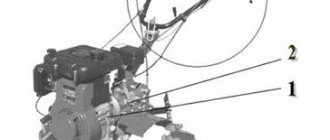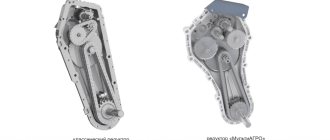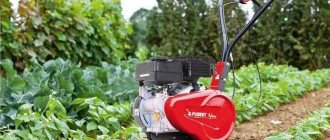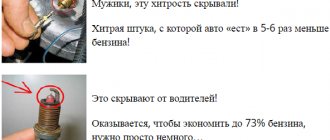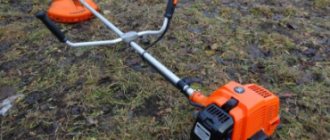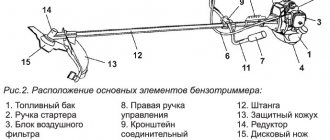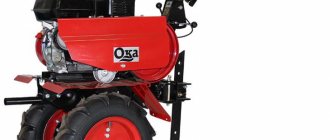The Carver walk-behind tractor is one of the highest quality units produced by the Perm production plant “Uraloptinstrument”. It has established itself as a gardening equipment with clear instructions and the ability to replace main components and spare parts.
Author of the article
Petr Mikhailovich
I know everything about walk-behind tractors and tractors.
In this article we will look at the models and their characteristics, as well as attachments.
About company
The Carver brand belongs to Perm and became famous in 2009, when it launched a range of gardening equipment on the market.
The products have proven themselves well in the agricultural machinery market.
The Perm assembly of these units is distinguished by good quality, reasonable price, simplicity of design and interchangeability of most components.
The easy assembly of walk-behind tractors implies hassle-free service, ease of repair and debugging, even without using professional tools and without resorting to the services of specialized workshops.
The engines installed on walk-behind tractors are analogues of Honda GX series engines, therefore they work well in tandem with a gearbox.
What it is?
First, a little theory. The Carver brand belongs to the Perm manufacturing enterprise Uraloptinstrument, which became widely known about 10 years ago when it launched the production of gardening equipment. Perm walk-behind tractors are characterized by decent quality, simple and understandable design, replaceability of main components and parts, as well as an affordable price.
The basic configuration of the walk-behind tractor allows you to loosen the soil while simultaneously removing weeds from it. Moreover, the functional features of the unit make it possible to transform it into a mini-tractor with wide capabilities. Carver products are able to cope with many complex tasks that homestead owners and small farmers often face. The power shaft together with the coupling can be combined with any type of mounted and trailed additional equipment, both domestic and foreign. Consumers have noticed that the engine works perfectly even on low-quality oil and fuel without losing its performance properties.
The walk-behind tractor is adapted to the Russian climate and can operate in any weather conditions - the performance of the unit is the same at both low and high temperatures. The volume of the fuel tank is quite large, so the unit can operate continuously for a long time without the need for refueling.
With a very substantial weight, the walk-behind tractor is very compact and ergonomic. It takes up very little space, so it can be transported in the trunk of any car, and even stored on the balcony. At the same time, the unit is quite maneuverable - it passes between bushes and trees without any problems. The equipment behaves quite steadily on uneven surfaces; moreover, it has a small parking support, which can be replaced with a third wheel when interacting with trailers.
All system control mechanisms are located on the handle. The steering wheel itself can be adjusted in width and height to make the operator’s work as easy as possible. The operator’s work is completely safe, since the person is reliably protected from stones from under the wheels and clods of earth by special wings made of plastic. All main components and mechanisms are covered with leather, and the gearbox housing is made of especially durable materials, thereby minimizing the risk of damage during mechanical collisions.
The cost of Carver walk-behind tractors is considered one of the lowest in Russia at the moment, and the quality does not suffer from this. Users claim that purchasing a Carver walk-behind tractor with a set of spare parts and additional elements is a profitable purchase today. The equipment can pay for itself in just a season, since the product is used almost every day, reducing the need for manual labor.
Model range of walk-behind tractors
T-400
The Carver T-400 motor-cultivator is a lightweight small unit weighing 29 kg, equipped with a four-stroke 4 hp engine.
It does not have a gearbox; torque is transmitted through a belt to a worm gearbox.
The clutch is operated by adjusting the degree of belt tension.
The crankshaft is located vertically, which simplifies the design of the walk-behind tractor and reduces the cost of its production. Ideal for cultivation, plowing and other work in small areas.
The motor-cultivator is designed for cultivating the surface layer of soil (soil) on small plots of land using milling cutters. Not for use with cart
Specifications
| Engine model | 168FB-2 (4-stroke petrol), OHV |
| Engine displacement, (cm. cubic meters) | 196 |
| Maximum power, hp, (kW)/rpm | 4,0 (3,0)/3600 |
| Working width | 380 mm` |
| Tillage depth | 220 mm |
| Speeds | 1 forward, neutral |
| Clutch | Belt |
| Weight | 28 kg |
MT-650M
The Carver MT-650 walk-behind tractor has compact dimensions and a simple design, and is also effective in operation. Equipped with a 4-stroke engine with an operating power of 6.5 hp. and a volume of 196 cm3, using gasoline as fuel.
Can be used for mowing grass, as a snow blower, and also for processing soil of various densities.
It has 2 forward gears and a reverse, which increases its maneuverability.
The air oil filter copes well with dusty air.
The model is equipped with wheels size 4.00-8, which provide improved maneuverability. The gear reducer easily transmits torque from the motor to the wheels.
The unit weighs 105 kg, can process a row 80-120 cm wide, and can also go deep into the soil up to 35 cm.
The walk-behind tractor is designed for cultivating soil, mowing grass, removing snow (with the help of an additional attachment-snow blower) in small and medium-sized areas, as well as performing a transport function.
Specifications
| Engine model | ZONGSHEN XP140A (4-stroke petrol), OHV |
| Engine displacement, (cm. cubic meters) | 196 |
| Power at 3600 rpm | 4.8 kW / 6.5 hp |
| Fuel tank volume, l | 4,8 |
| Working width | 800-1200 mm` |
| Tillage depth | 100-350 mm |
| Speeds | 2 forward, neutral, 1 reverse |
| Clutch | Belt |
| Weight | 97 kg |
MTL-650
The Carver MTL-650 walk-behind tractor weighs 91 kg, which allows it to be used for cultivating soil without weights.
Equipped with a 4-stroke gasoline engine producing 6.5 hp, with a working volume of 196 cm3.
Thanks to the presence of tillers, the unit can plow the ground to a depth of up to 20 cm, be used as a snow blower, or transport loads using a trailer.
The device has 2 forward gears and one reverse gear, which significantly increases maneuverability.
Wheels on tubeless tires measuring 4.00-8 do not get stuck on wet ground, and a capacious 4.8-liter gas tank allows you to work for about 5 hours without refueling.
The processing width of a row can vary from 50 to 100 cm. The unit is equipped with an air-oil filter, which increases the service life of the motor, and also has a transport wheel for ease of movement.
Specifications
| Engine model | 168FB-2 (4-stroke petrol), OHV |
| Engine displacement, (cm. cubic meters) | 196 |
| Maximum power, hp, (kW)/rpm | 4.8 kW / 6.5 hp |
| Fuel tank volume, l | 4,8 |
| Working width | 500-1000 mm` |
| Tillage depth | 150-250 mm |
| Speeds | 2 forward, neutral, 1 reverse |
| Clutch | Belt |
| Weight | 83 kg |
MT-900
The CARVER MT-900 walk-behind tractor is a professional-level model, as it is equipped with a 9 hp engine.
Its significant weight of 141 kg allows it to be used without weights, and large pneumatic wheels can easily overcome off-road conditions.
The unit is equipped with reverse and two forward gears, thanks to which improved maneuverability is achieved.
Although it is worth noting that with such large dimensions as the MT-900, it is difficult to achieve effective maneuvering.
The plowing width varies depending on the amount of rototiller use. The launch is carried out manually, but additional effort on the part of the operator is not required.
Equipping with a power take-off shaft allows you to connect additional equipment.
Specifications
| Engine model | 177F (4-stroke petrol), OHV |
| Engine displacement, (cm. cubic meters) | 270 |
| Power at 3600 rpm | 6.5 kW / 9.0 hp |
| Fuel tank volume, l | 6.0 |
| Working width | 800-1200 mm` |
| Tillage depth | up to 350 mm |
| Speeds | 2 forward, neutral, 1 reverse |
| Clutch | Gears |
| Weight | 83 kg |
Specifications
The manufacturer provides the following characteristics of the Carver walk-behind tractor in the instructions:
- gear clutch, which operates due to a trapezoidal belt;
- front derailleurs of two speeds and one reverse;
- pneumatic wheels made of durable rubber;
- four-stroke engine that runs on both gasoline and diesel;
- internal combustion engine cooling system;
- Efficiency – 6-9 hp;
- travel speed – 3.6-7.2 km/h;
- width and depth of grip – 120 and 35 cm.
Attachments
Due to the fact that Carver models are equipped with a power take-off shaft, it is possible to use various attachments, which not only expand the capabilities of the walk-behind tractor, but also simplify many works on the farm.
Below is a list of additional equipment that is used with Carver walk-behind tractors:
- A rotary mower is designed for cutting grass or trimming a lawn. As a result of the work, all the grass is folded into rows, which facilitates its further raking.
- Grousers are used when performing complex work such as plowing, hilling or harrowing. Moving the walk-behind tractor on loose soil is greatly simplified.
- A plow with a hitch is capable of not only digging up the ground, but also making even furrows, which can later be used for planting.
- Cultivators "Crow's feet" are non-separable equipment with a specific design. Used for weeding a large number of weeds.
- The trolley is used to transport various goods. A special feature of the model is the ability to fold down the side to facilitate loading and unloading.
- A potato digger is the most necessary equipment, which is purchased additionally, as it greatly facilitates the harvesting of root crops.
- The two-row hiller is used to create furrows when sowing various crops.
- The segment mower is designed for cutting grass on the lawn. As it moves, the landscape of the soil is repeated, which makes it possible to use it in areas with uneven surfaces.
Points that make working with a motor cultivator easier
It is better to go through the row several times, without immediately going as deep as possible. This way there is less load on the motor cultivator itself and the quality of the row is better.
If the soil is hard, then hilling can be done with cutters. If the soil is soft and hilling occurs after weeding, it is better to use lugs. With them, hilling is more efficient and the motor cultivator does not get buried. And the lugs themselves do a good job of loosening the soil without turning it into dust, as would happen with cutters.
Features of use
An important factor for extending the life of cultivators is timely maintenance.
The instructions for use provide a table according to which maintenance is carried out, including such operations as changing the oil, replacing the air filter, spark plugs, adjusting the gaps between the valve stem and the pusher, tensioning belts, etc.
When using the walk-behind tractor in dusty conditions, it is recommended to carry out more frequent maintenance and inspections.
Changing the engine oil is carried out while the engine is still warm, because otherwise not all the lubricant will leak out. A container is placed under the drain neck, the plug is turned out and the oil is drained by gravity.
Fill in a new lubricant only according to the manufacturer's recommendations: SAE 80W-90, SAE 85W-90 or similar.
It is advisable to dispose of used oil properly, namely by handing it over to a waste disposal service.
Preparation for long-term storage
If you plan not to use the walk-behind tractor for a long time, adhere to the following storage rules:
- The fuel needs to be drained.
- Clean the machine from dirt and adhering grass.
- Remove the spark plug and add 15 ml of engine oil, then install the spark plug in place.
- Pull the starter until resistance is felt. Continue pulling until the mark on the starter pulley aligns with the hole on the housing.
- Wipe all unpainted surfaces with a cloth lightly moistened with oil. This will prevent the occurrence of corrosion.
- Cover the walk-behind tractor from dust.
- Store in a dry and ventilated area.
Trouble-shooting
| Engine doesn't work | The ignition is not turned on; There is no fuel or oil, they may be out of date; No spark; Dirty air filter; |
| The engine stalls | The air damper or fuel valve is closed; The filter is clogged; Faulty spark plug. |
| Noise from gearbox | Bearing wear, which is better replaced with a new one; Deformation of sprocket teeth; Little lubricant or poor quality |
| V-belt slipping | Oil on belt or pulley; Weak belt tension; The belt is worn or deformed. |
For more information, please follow the link—>
Run-in
The cycle of procedures that are necessary for the successful operation of a walk-behind tractor is called running-in. It is usually carried out after purchase, while the walk-behind tractor is new, or after long-term storage of the unit.
The manufacturer strongly recommends running-in according to all the rules without neglecting it, since at this time the engine parts and large components of the unit are being ground in.
- Start the engine at idle speed and let it run for 20 minutes.
- After a while, carry out gas control, which is carried out by squeezing maximum speed. Gas release should not last more than 20 seconds.
- Work in this mode for 4 hours, alternately changing idle speed and throttle control.
- For the next 4 hours, you can use the walk-behind tractor, but without attachments. The manufacturer offers to attach the wheels and ride the walk-behind tractor.
- After 8 hours of running-in, drain all the oil and replace with new one.
List of additional options
The basic configuration of the unit makes it possible to loosen the soil and simultaneously remove weeds from it along with the roots. The capabilities of the machine allow you to turn it into a multifunctional mini-tractor with extensive capabilities. Almost all user reviews contain recommendations on the advisability of equipping the equipment with additional equipment.
The following options can be installed on the walk-behind tractor:
- Plow. The weight of the unit and a powerful motor create all the conditions for attaching a plow with 2-3 shares to the hitch, which makes it possible to plow a strip up to 100 cm wide. A single share is used when raising virgin soil, digging trenches and developing terrain for a foundation.
- Hiller. This is a very practical device with which beds are formed. As a result of treatment, more oxygen is supplied to the roots of plants, and excess moisture does not remain in them after rain. At the same time, weeds are removed between the beds.
- Various types of mowers. To mow hay, tops and weeds over a large area, it is better to use a rotary mower with a working width of 120 cm. With this device you can easily process up to 1 hectare per day. It is advisable to mow lawns in the yard using a trimmer.
- Devices for growing root crops. Agricultural workers speak positively about potato planters and potato diggers. The devices are rigidly fixed to the back of the walk-behind tractor, providing an immersion depth of up to 27 cm and a working width of 30 cm.
- Snow removal equipment. Using various types of canopies on Carver, the operator can quickly and efficiently remove snow from areas and paths, near gates, garages and fences. A rotary cleaner, a wide decoction and rotating hard brushes are used.
- Trailer devices. A cargo trailer or a combination trolley with seats for passengers can be attached to the walk-behind tractor. The power of the unit is enough to tow a trailer weighing up to 500 kg. To transport cargo through the snow, sleds made of polymer materials are used.
- Weights. In cases where the mass of the unit is not enough for reliable adhesion to the ground, special devices are used. Removable weights are attached to the axle shafts or to the body of the machine. Instead of wheels, you can install ground hooks weighing up to 70 kg and with a diameter of up to 60 cm.
The presence of several speeds allows you to choose the optimal operating mode for performing any kind of task.
Owner reviews
Owners of Carver walk-behind tractors note a weak protective structure and inconvenient placement of spark plugs. But in general, we can conclude that there are more positive emotions during exploitation than dissatisfaction.
Maxim
Artem : “I really like the Carver MT-650 walk-behind tractor, as it allows you to quickly plow 50 acres of virgin land.
However, the lump protection is very weak and quickly cracked. Difficult to shift gears, they don’t immediately go into place. If you tilt the walk-behind tractor, oil flows into the cylinders, which can lead to problems when starting. Among the advantages I would like to include the engine, which, despite all the difficulties, works properly.” We invite you to leave a review if you are the owner of CARVER walk-behind tractors. The information you provide can help our readers choose a cultivator model.
Powerful and inexpensive Carver walk-behind tractor
The Carver walk-behind tractor belongs to the category of small agricultural equipment for individual use and public utilities. This unit was developed in Omsk, which has a harsh climate and unpredictable weather. It was for operation in such conditions that the Carver MT-900 walk-behind tractor and its modification MT-650 were created. The manufacturer has provided for the increased loads that the equipment will experience when operating on heavy soil, at high and low temperatures. The Carver 650 walk-behind tractor is assembled from components and mechanisms that have an increased safety margin. The highest quality materials and advanced technologies are used in its assembly. Engines for Carver walk-behind tractors were originally manufactured in Omsk.
Subsequently, due to a number of political and economic factors, the production of power plants was transferred to China. However, this did not affect the quality of Carver MT-900 products and the price. Due to reliability and availability, the Omsk market offers walk-behind tractors of various models, equipped with mounted and trailed equipment.
Tillage
Most often, walk-behind tractors Cayman Vario, Patriot Ural, Texas, Foreman, Viking, Forza, Patriot are purchased for cultivating land. On most walk-behind tractors, cutters are installed instead of wheels, but on some models they have a separate drive.
Cultivation is a highly productive processing process that combines loosening the soil with the destruction of weed roots, but only on dry soil. When processing wet soil, the cutter becomes clogged with clods and cannot chop it.
Also, when cultivating soil with a cutter, a certain skill and the correct choice of operating mode are required so that the processing takes place at a constant depth and the cutter is not pushed out or buried.
As a rule, an overdrive is used if the engine power is sufficient to pull the walk-behind tractor on it at the selected processing width. Most medium-sized walk-behind tractors with gasoline engines with a power of 6.5 horsepower allow you to cover an area up to 120 centimeters wide in one pass.
Tillage
To cultivate heavy soils, a plow is traditionally used, which, when pulled, lifts and turns the layers of earth outward. Unlike cultivation, which is carried out in high gear, plowing with a plow is carried out in the lowest gear, as it requires significant effort.
For successful plowing, high-quality adhesion of the walk-behind tractor wheels to the ground is necessary, so welded wheels with large lugs are often used for this. Particularly popular are designs whose rims are made of several hoops, since they are not clogged with earth.
When plowing with a plow, it is important to correctly adjust its share - this applies to both the angle of attack (if it is incorrectly installed, the plow will bury itself in the ground or tend to go out), and the width of the share - the optimal position of its right edge should be in the same plane with the inner edge of the right wheel. Thus, when passing, it forms an even furrow, distributing the earth over neighboring boletus
Thus, as it passes, it forms an even furrow, distributing the soil over adjacent boletus.
More productive designs are hillers with two shares and disk hillers, the knives of which look like rotating disks.

